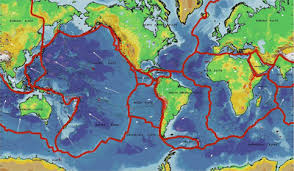Sunday 30 January 2011
Wave Simulator
What I have realized was that the more the amplitude was, the higher the wave was. The higher the frequency, the more waves are produced, and they come faster. When a barrier is added, the waves receive a higher frequency and amplitude. The waves basically just bounce back from the barrier(s), then the wave(s) interferes with the other wave(s), then it goes around the barrier making ripples, or sometimes, if the wave is strong enough, it takes the shape of the barrier. In some rare situations, or just when the wave is strong enough, the wave will take the shape of the barrier.
Wednesday 26 January 2011
Bill Nye: Earthquakes

This is a rector scale!
A rector scale is used to express the total amount of energy released by an earthquake.

This is a Seismometer!
A Seismometer is an instrument fro measuring earthquakes.
This is a Seismograph!
A seismograph is an instrument for automatically detecting and recording the intensity, direction, and duration of a movement of the ground, especially of an earthquake.
A seismic wave is an earth vibration generated by an earthquake or explosion

These are the Tectonic Plates!
Tectonicplates are the two sublayers of the earth's crust (lithosphere) that move, float, and sometimes fracture and whose interaction causes earthquakes.
This is an Epicenter (well it shows where the Epicenter is)!
An Epicenter is the point on the Earth's surface that is directly above the focus (the point of origin) of an earthquake. The epicenter is usually the location where the greatest damage associated with an earthquake occurs.
This is a Fault!
A fault is a crack in the Earth's crust. Typically, faults are associated with, or form, the boundaries between Earth's Tectonic plates In an active fault, the pieces of the Earth's crust along a fault move over time. The moving rocks can cause earthquake. Inactive faults had movement along them at one time, but no longer move.
There are thousands of earthquakes every year. When the tectonic plates come together they can create mountains. When plates slip, earthquakes, lava make a party! The hot molecules need more space, magma is extremely hot. To make islands, sometimes the hot magma goes into the ocean and creates a hard rock, eventually becoming an island. Also there are underwater volcanoes which over time build up hard magma, and create an island. The earth and magma underneath can be compared to liquid chocolate hardening. When it is somewhat dry, it creates a hard top layer. Still the magma or chocolate underneath is not dry, so when you tilt the chocolate bowl the liquid chocolate or magma moves the top layer of dried chocolate. When the magma tilts towards the ocean, the molten magma moves the surface of the earth while moving.
Each country has one of these stations so when someone from India can feel and earthquake, someone from Indonesia can feel the earthquake and someone from Cape Town, South Africa can feel the earthquake.The epicenter is where natural disasters come from.
Each country has one of these stations so when someone from India can feel and earthquake, someone from Indonesia can feel the earthquake and someone from Cape Town, South Africa can feel the earthquake.The epicenter is where natural disasters come from.
Monday 17 January 2011
How do waves interact?
No Barriers:
In the tub whom didn't have any barriers, in all the tries I had putting them in different corners, the result was always the same; the waves just went through each other. Honestly what I thought was going to happen was that the waves would meet up in the middle and just burst up.
One Barrier:
In the tub with one barrier (the same tub just I added one barrier to it,) I got the same results as I got with no barriers; the waves went through each other and through the barrier. I thought that the waves would make the barrier move out of place, but then I realized that since both waves were the same strength and went in the same speed, that means that they are both pushing the barrier with the same amount of strength meaning that it won't move, if only one wave would've been pushing it then it might have moved (depending on the strength of the wave.)
Two Barriers:
Only in on of the 3 tries I had (putting the barriers in different places) did the wave not manage to somehow get through. In a different try (the second try,) only one of the waves (after 2 reflections) managed to get around the barrier. In the third try, the waves just went through the barriers.
All-in-all, I conclude that in most cases, the waves would just go through the barriers, while in the less common cases, they would bounce back.
Subscribe to:
Posts (Atom)